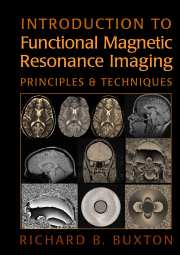12 - Noise and Artifacts in Magnetic Resonance images
from IIB - Magnetic Resonance Imaging
Published online by Cambridge University Press: 05 September 2013
Summary
IMAGE NOISE
Image Signal-to-Noise Ratio
Chapter 10 described how the local magnetic resonance (MR) signal is mapped with magnetic resonance imaging (MRI). However, noise enters the imaging process in addition to the desired MR signal, so the signal-to-noise ratio (SNR) is a critical factor that determines whether an MR image is useful (Hoult and Richards, 1979; Macovski, 1996; Parker and Gullberg, 1990). The signal itself depends on the magnitude of the current created in a detector coil by the local precessing magnetization in the body. The noise comes from all other sources that produce stray currents in the detector coil, such as fluctuating magnetic fields arising from random ionic currents in the body and thermal fluctuations in the detector coil itself.
The nature of the noise in MR images is critical for the interpretation of functional magnetic resonance imaging (fMRI) data. The signal changes associated with blood oxygenation changes are weak, and the central question that must be addressed when interpreting fMRI data is whether an observed change is real, in the sense of being due to brain activation, or whether it is a random fluctuation due to the noise in the images. This remains a difficult problem in fMRI because the noise has several sources and is not well characterized. Noise is a general term that describes any process that causes the measured signal to fluctuate when the intrinsic NMR signal is stable. In MRI, there are two primary sources of noise: thermal noise and physiological noise. We will begin with the thermal noise because it is better understood and take up physiological noise at the end of the chapter.
Information
- Type
- Chapter
- Information
- Introduction to Functional Magnetic Resonance ImagingPrinciples and Techniques, pp. 274 - 306Publisher: Cambridge University PressPrint publication year: 2002
